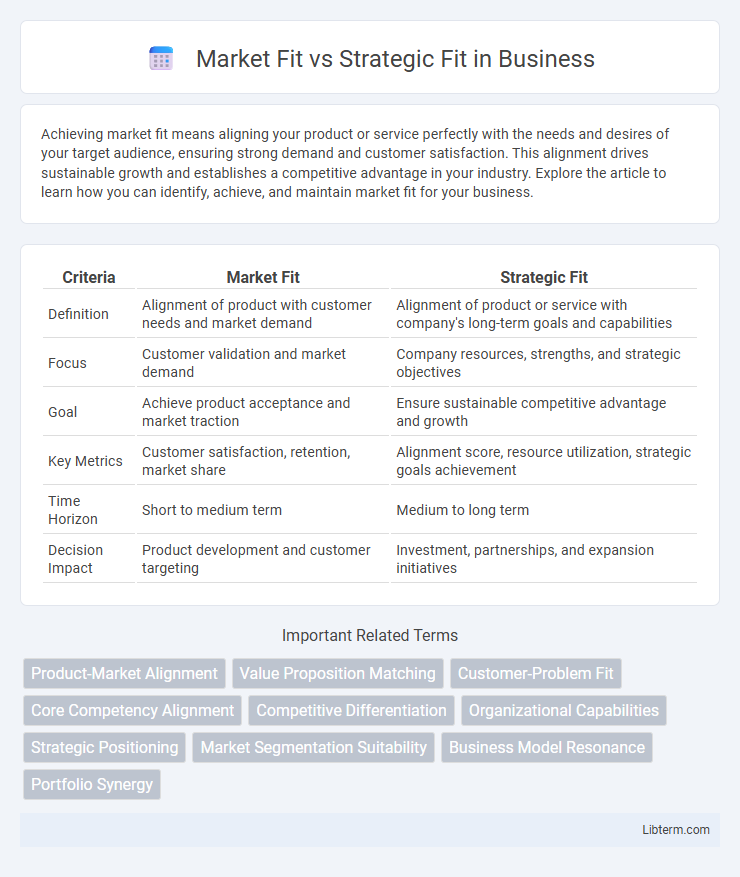Achieving market fit means aligning your product or service perfectly with the needs and desires of your target audience, ensuring strong demand and customer satisfaction. This alignment drives sustainable growth and establishes a competitive advantage in your industry. Explore the article to learn how you can identify, achieve, and maintain market fit for your business.
Table of Comparison
| Criteria | Market Fit | Strategic Fit |
|---|---|---|
| Definition | Alignment of product with customer needs and market demand | Alignment of product or service with company's long-term goals and capabilities |
| Focus | Customer validation and market demand | Company resources, strengths, and strategic objectives |
| Goal | Achieve product acceptance and market traction | Ensure sustainable competitive advantage and growth |
| Key Metrics | Customer satisfaction, retention, market share | Alignment score, resource utilization, strategic goals achievement |
| Time Horizon | Short to medium term | Medium to long term |
| Decision Impact | Product development and customer targeting | Investment, partnerships, and expansion initiatives |
Understanding Market Fit: Definition and Importance
Market fit refers to how well a product satisfies the demands and preferences of a specific target audience, often measured by customer adoption, retention, and satisfaction rates. Achieving market fit is critical for business success as it validates the product's value proposition and drives sustainable revenue growth. Understanding market fit helps companies align product development with market needs, reducing the risk of product failure and optimizing marketing efforts.
Defining Strategic Fit in Business Context
Strategic fit in a business context refers to the alignment between a company's internal capabilities and external market opportunities, ensuring resources and competencies complement long-term goals. It involves assessing how well a business's strategies, operations, and objectives harmonize with industry trends, competitive dynamics, and stakeholder expectations. Achieving strategic fit enhances sustainable competitive advantage by optimizing synergy across business units and market demands.
Key Differences Between Market Fit and Strategic Fit
Market fit refers to how well a product or service satisfies the needs and preferences of a target customer segment, emphasizing demand validation and user adoption metrics. Strategic fit assesses the alignment between a business's internal capabilities, resources, and long-term objectives with external market opportunities and competitive dynamics. The key differences lie in market fit's focus on customer satisfaction and market demand, while strategic fit centers on organizational alignment and resource leveraging for sustainable competitive advantage.
Indicators of Achieving Market Fit
Indicators of achieving market fit include strong customer demand demonstrated by consistent sales growth and high customer retention rates, reflecting satisfaction with the product's value proposition. Positive product-market feedback loops, such as frequent referrals and low churn rates, signal alignment with customer needs and expectations. Metrics like increasing conversion rates from trial to paid customers and rising user engagement further validate successful market fit.
Assessing and Measuring Strategic Fit
Assessing strategic fit involves evaluating the alignment between a company's internal capabilities and its external market opportunities, using metrics such as resource complementarity, operational synergy, and long-term competitive advantage. Measuring strategic fit requires quantitative tools like strategic audits, SWOT analysis, and portfolio matrices to gauge how well strategic initiatives support overall corporate goals. Effective strategic fit assessment enables firms to prioritize investments and partnerships that enhance sustainable growth and market positioning.
When to Prioritize Market Fit over Strategic Fit
Prioritize market fit over strategic fit when launching new products or entering unfamiliar markets, as aligning with customer needs and preferences ensures initial adoption and sustainable revenue growth. Market fit drives product-market validation through customer feedback, demand signals, and competitive analysis, which are critical for scaling business operations effectively. Emphasizing market fit first minimizes risks associated with misaligned offerings and establishes a foundation for later strategic integration and long-term competitive advantage.
Aligning Product Development with Strategic Objectives
Market fit emphasizes tailoring products to satisfy specific customer needs and preferences, ensuring strong demand and user adoption. Strategic fit focuses on aligning product development with the company's broader goals, resources, and competitive positioning to enhance long-term value. Successfully integrating market fit with strategic fit drives innovation that meets market demands while reinforcing organizational strengths and future growth potential.
Challenges in Balancing Market Fit and Strategic Fit
Balancing market fit and strategic fit presents challenges such as aligning customer needs with long-term organizational goals while maintaining competitive advantage. Companies often struggle to innovate products that satisfy immediate market demands without compromising their core strategic vision or resource capabilities. Achieving equilibrium requires continuous market analysis, adaptive strategy formulation, and robust stakeholder collaboration.
Real-World Examples: Market Fit vs Strategic Fit
Market fit is exemplified by companies like Airbnb, whose product meets a clear customer demand for affordable, flexible lodging, resulting in rapid user adoption and revenue growth. Strategic fit is demonstrated by Disney's acquisition of Marvel, which aligned perfectly with Disney's broader entertainment ecosystem, leveraging existing marketing and distribution channels to maximize value. Both concepts are essential in business decisions, where market fit focuses on customer needs and strategic fit emphasizes synergy between business units or partners.
Best Practices for Ensuring Both Market and Strategic Fit
Achieving both market fit and strategic fit requires rigorous customer validation and alignment with core business objectives, ensuring products address real customer needs while complementing company capabilities. Employ tools like value proposition mapping and strategic SWOT analysis to identify market opportunities that reinforce long-term competitive advantages. Continuous feedback loops from target customers combined with internal alignment workshops foster adaptable strategies that maintain coherence between market demands and strategic goals.
Market Fit Infographic

 libterm.com
libterm.com